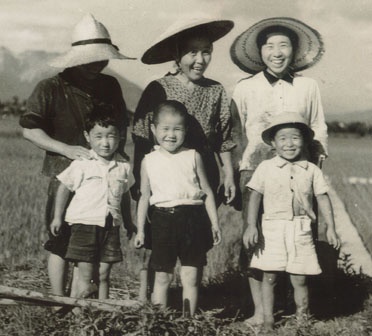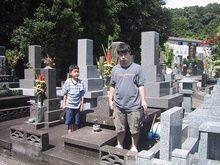Sansei Ken Noma, 60, a well-known community activist whose involvement stretches back three decades, was elected as the new president of the National Association of Japanese Canadians (NAJC) in October 2010.
The retired Toronto high school teacher began his community involvement in the 1970s as a McMaster University student in Hamilton, Ontario. He’s been actively involved with the Asian and Nikkei communities since then, including the Redress movement in the 1980s, and has come out of retirement to become involved at the national level, replacing outgoing NAJC president, Terumi Kuwada.
Personally, I have a lot of concerns about the future of the Nikkei community in Canada. If our tiny community of about 60,415 in 2006 (down from 68,135 in the 1996 census) is going to continue to exist, we are going to have to break free of the strangle hold that prevents some communities from evolving beyond the self interests of “special” groups. It is also clear that we have not held our own culturally in a multicultural society where the interests of more dominant groups (we represent only 0.2 percent of Canada) are affecting the Canadian cultural landscape. We have generally failed to define what-it-is-to-be Nikkei for younger Canadians of Japanese descent. As our community stands today, we are a polarized community of Ijusha, who are culturally more closely linked to Japan, and the pre-World War Two immigrants, who are generally clueless about Japanese culture and the language. As we move further and further away from “Japan,” the challenge is to find some compelling reason for these disparate groups to form a united community. In 2011, this is still a pipe dream, unfortunately.
Why is it important for us to maintain a relationship with a country which the vast majority of Canadian-born Nikkei have never been to? What aspects of “Japaneseness” are worth integrating into our sense of Canadian “Nikkeiness”? Is being “Japanese” really anything more than a cultural fetish?
Like it or not, it was heartening to see the NAJC take a stand on the on-going Macleans magazine controversy centering around its November 10th “University Issue” that was entitled: “Too Asian?”. They along with a coalition of Asian Canadian groups are demanding an apology for the particular “slant” of that issue from Rogers Communications, which owns the magazine. I felt some pride that “our” community had spoken out about an issue that should concern us all. Noma points out that the 2006 Canadian census found that 38 percent of Nikkei, aged 15 and older, reported that they had either experienced racial discrimination or unfair treatment as a result of their racial and ethnic background.
I begin then wondering what might be the consequence to Canadian Nikkei if we did not have the NAJC?
Can you give us a history of your involvement in the Nikkei community? When did it all begin, what was your involvement during Redress and what have you been doing since?
Let me first begin, Norm, by noting that my views expressed here may not necessarily reflect the official policy of the National NAJC nor those of our chapter organizations.
I first became involved directly with the Japanese Canadian community in my final year of studies at McMaster University in 1975. At that time, I was offended with the use of the racist word, “Chinamen,” contained in the lyrics of the song, “Kung-Fu Fighting” that was being played on all the rock stations in Hamilton and across North America. As Chairman of the McMaster Students’ Union, I had a motion passed requesting that the Hamilton radio stations take the song off the air. The request naturally drew the attention of the local paper, The Hamilton Spectator. The reporter from the paper asked me if I was Chinese and informed me that the owner of the prominent Aero Restaurant did not find the word offensive to her. In fact, she had told him that she had been called worse. I did not realize that racist words had different level of acceptability. I learned a valuable lesson from that experience which was that part of fighting racism was to educate members within your own community as much as the larger, dominant culture.
Can you tell us a little about your family and parents?
My father and his siblings were born in Maple Ridge and raised in Laskin, British Columbia. Prior to World War II the family moved back to the southern Japanese city of Kagoshima, except for my grandfather who remained behind to work in the lumber camps; subsequently, he was interned during the War and rejoined the family after the cessation of hostilities. My mother is an Issei born and raised in Kagoshima City. By virtue of my father’s dual citizenship, we were able to immigrate to Canada in 1959.

(L-R) Ken's mother and Ken, his paternal grandmother and cousin Katsunori Onimaru, his aunt and cousin Toshiaki Noma. The volcano, Sakurajima is in the background and they are at his family rice paddy. Photo was taken in 1956 (Photo courtesy of Ken Noma)
So, why did you come out of retirement to run for the NAJC presidency?
Although I retired as a high school history teacher in 2006 after 30 years with the Toronto District School Board, I have always been active as a volunteer in the Japanese Canadian community since 1975. Prior to my election as President of the NAJC, I was Vice-President of the Heritage Committee at the Japanese Canadian Cultural Centre (in Toronto). My good friend, Henry Kojima is quite a salesman and he persuaded me to come back “home” to the NAJC by running for the office of President. I am glad that I did and I am grateful to those who encouraged me and supported my candidacy, especially members of the Toronto and Hamilton Nikkei community.
What kind of leadership do you hope to bring to the community?
Leadership is about teamwork and one person cannot be the sole “change-agent.” There are a total of seven NAJC Executive Members along with numerous Chairs of Standing Committees as well as chapter executive members to provide leadership. I see my role as a facilitator and to bring on board people who have the ability and desire to implement innovative programmes. At some point, most volunteer, non-profit organizations suffer from inertia due to complacency. The NAJC is no different and as such we need to revisit the founding principles and bring forward effective programmes that will engage the community, in particular, the youth and new immigrants. I believe that one must lead by example and be driven by a sense of reasoned urgency. Often too much time is taken in discussions at the expense of action.
As the first Ijusha president, how does this affect how you see what our community needs at this time in our history?
Until you posed this question, I had not considered myself as an Ijusha and had seen myself as a Sansei given my father’s birth in British Columbia. Being born in Tokyo and raised in Kagoshima, the first eight years of my life, I suppose I may fit under the definition of Ijusha. Nevertheless, I believe that once you leave your ancestral home, you are a Nikkeijin whether you are recently arrived or have been here for many decades. Years ago, one of my students asked me if I cognitively thought in English or Japanese to which I replied, “both.” When I see a work by Sansei artists, performers, or writers, I see elements in the work that reflects their ancestral culture; elements which they themselves may not be aware. Labels are just that and I feel they do not affect my perception of the needs of the Nikkei community. I have faced the challenges of trying to learn a new language and new customs and I can empathize with the plight of new immigrants. We must recognize the fact that newly arrived immigrants from abroad do face special acculturation challenges and here I must applaud the invaluable work of the Toronto-based Japanese Social Services and Vancouver’s Tonari Gumi in providing specific aid to immigrants and families in crisis. We must find financial resources to continue the work of such organizations.
Part 2 of interview with Ken Noma >>
© 2011 Norm Ibuki







